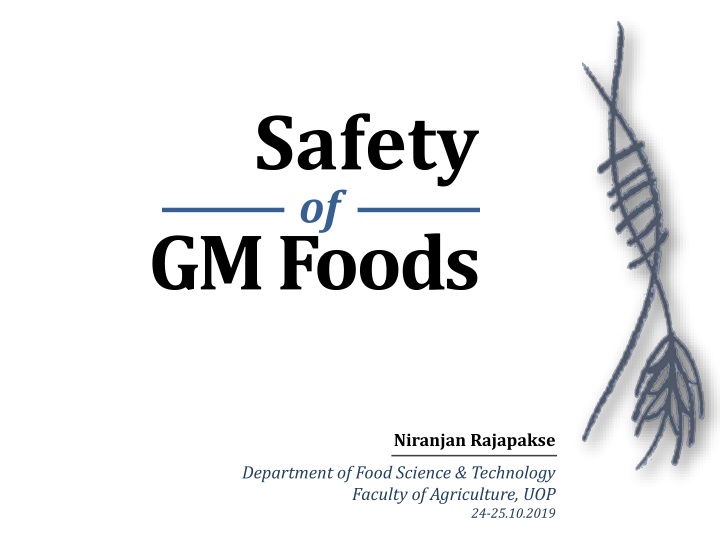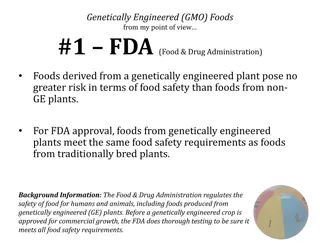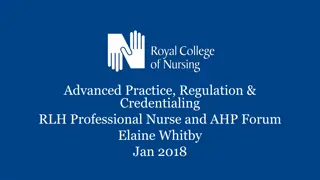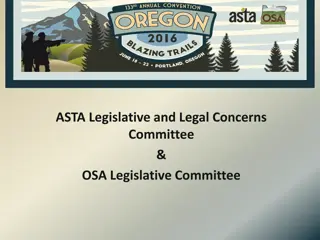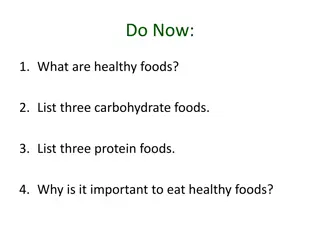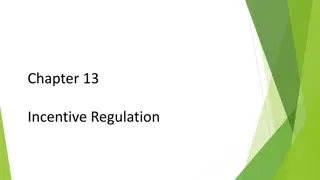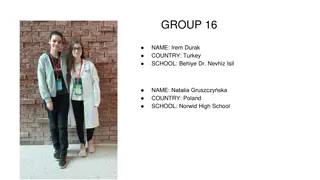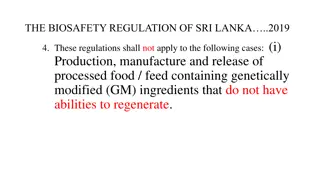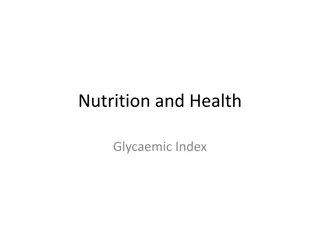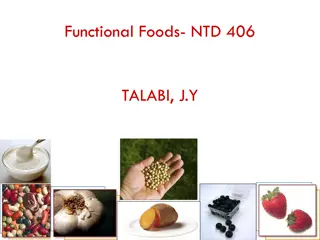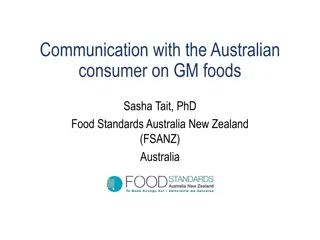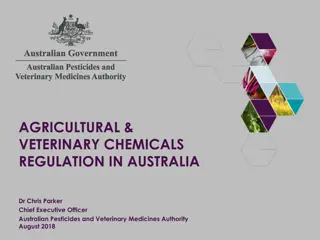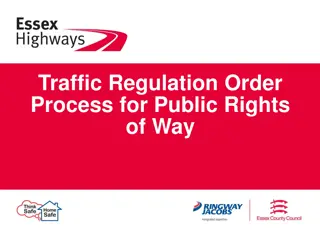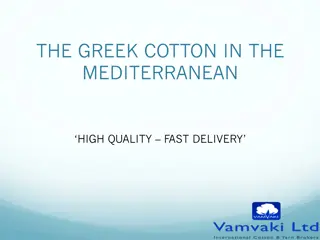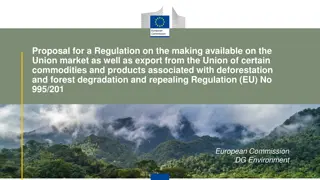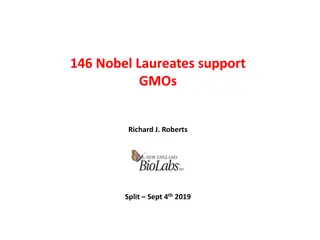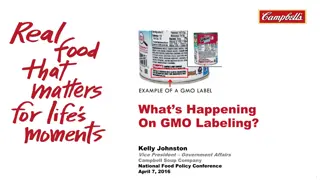The Safety and Regulation of GMO Foods
Explore the importance of genetically modified organisms (GMOs) in healthcare, agriculture, and food industry, along with the safety concerns, regulatory assessments, and international standards associated with GMO foods. Learn about the benefits, potential risks, and management strategies for ensuring the safety of GMO foods.
Download Presentation

Please find below an Image/Link to download the presentation.
The content on the website is provided AS IS for your information and personal use only. It may not be sold, licensed, or shared on other websites without obtaining consent from the author.If you encounter any issues during the download, it is possible that the publisher has removed the file from their server.
You are allowed to download the files provided on this website for personal or commercial use, subject to the condition that they are used lawfully. All files are the property of their respective owners.
The content on the website is provided AS IS for your information and personal use only. It may not be sold, licensed, or shared on other websites without obtaining consent from the author.
E N D
Presentation Transcript
Safety GM Foods of Niranjan Rajapakse Department of Food Science & Technology Faculty of Agriculture, UOP 24-25.10.2019
Why GMOs ?.. Health care Vaccines, antibiotics, antibodies, hormones (> 300 approved biologics) Agriculture New plant cultivars: yield, nutritional quality, resistance (16 crops in 28 countries) Food industry plant (tomato, potato, corn, soybean ..) & animal (salmon) raw materials, microorganisms (probiotics, Enzymes: rennet ..) 2
GM Food Crops & Animals Food fish Salmon 0 Crops Papaya Potato Soybean Squash Sugar beet Apple Tomato (1st crop: 1996) Beet pepper Canola Egg plant (Brinjal) Maize 3
Safety of GMOs (Biosafety) Environmental Safety Concerns on biodiversity (environment) Horizontal gene transfer Impact on non-target organisms Development of pest/ disease resistance Food Safety Health concerns to the consumers Toxicity Allergenicity Nutritional Effects Digestibility 4
Safety Assessment of GMOs Two distinct assessments But, shares common information Food safety assessment Env. risk assessment Molecular characterization 5
Food safety concerns Some genes used have not been in the food before or have no history of safe food use. May produce new unexpected proteins that are toxic or allergenic. Existing traits could be lost or modified. Harmless protein in one organism can be harmful in another organism (post- translational modification). 6
Managing GM food safety Specific premarket regulatory systems established by many countries with case-by- case risk assessment of each GM food are generally accepted. However, harmonization of the different methods used on an international basis is needed. At the international level, agreements and standards are available to address specific concerns on GM food safety. 7
Codex documents on GM food safety Principles for the Risk Analysis of Foods Derived from Modern Biotechnology (2003) Guideline for the Conduct of Food Safety Assessment of Foods Derived from Recombinant DNA-Plants (2003) Annex on Food Safety Assessment of Foods Derived from Recombinant-DNA Plants Modified for Nutritional or Health Benefits (2008) Annex on Food Safety Assessment in Situations of Low-level Presence of Recombinant-DNA Plant Material in Food (2008) FAO/WHO Expert Consultation on the Safety Assessment of Foods Derived from Genetically Modified Animals, including Fish (2003) 8
Basic principle of safety assessment GE does not result in food which is inherently less safe than that produced by conventional means (FAO/WHO, 1991) Use scientific risk-based methods Case-by-case basis assessment Intended and unintended effects of genetic modifications are considered 9
Comparative Assessment Principle: GM food is compared with conventional counterparts that have an established history of safe use. Objective: To determine if the food presents any new or altered hazard. Goal: To develop a reasonable certainty that no harm will result from its intended use under the anticipated conditions of processing and consumption. (But, not to establish an absolute level of safety) 10
Risk Analysis Framework Risk Communication Risk Option characterization implementation Risk Risk Assessment Management Hazard Monitoring & review characterization Hazard identification Food labeling, conditional marketing approvals, post- marketing monitoring 11
Safety Assessment Framework 1. General Information Description of the GMO Description of host and its use as food Description of donor organism(s) Description of the genetic modification(s) Characterization of the genetic modification(s) History of safe use Is the product of an inserted gene/s harmful when consumed by humans or animals Understand its biology or method of action (eg: Bt protein) 12
2. Safety Assessment Expressed substances (intentional modifications) Potential toxicity and allergenicity Compositional analyses of key components Evaluation of metabolites Effects of food processing Nutritional modification Other considerations (e.g. marker genes) 13
Safety Assessment: Test samples Safety is assessed for the original GM food material, but not for the derived products. All the parts of the organism that may be used as food are used as test samples. Eg: GM corn: Samples- oil and corn meal (intended food materials) Eg: GM tomato: Sample- fruit 14
Safety Assessment: Intentional modifications Nature of the new gene Biological function (s) of new protein/ enzyme Derived metabolic product(s): functions and concentrations 15
Safety Assessment: Acute Toxicity Pure protein feeding to rats Limit dose of 2000 mg/ Kg body weight 14 days observation for mortality and morbidity Protein produced using bacterial expression system and confirmed for functional homology with native protein 16
Safety Assessment: Allerginicity Amino Acid sequence homology with any allergen from database (8 amino acid segments) < 35% homology over a 80 AA stretch: low probability of allergen Protein digestibility: Resistant to digestion (allergen ?) Thermal stability: Resistant to heat (allergen ?) If any of the above 3 tests are positive, unlikely that the transgene would be approved Serological tests for confirmation 17
Safety Assessment: Compositional analyses Assess how similar is the GMO to what is considered to be the conventional safe organism Major constituents (fats, proteins, carbohydrates as nutrients or enzyme inhibitors as anti-nutrients) Minor compounds (minerals, vitamins) Deviations outside natural variability may indicate need for further evaluation, case-by-case. Huge variation within the limit (conventional or otherwise) is normal and unavoidable. Thus NOT a safety concern. 18
Safety Assessment: Processing & Consumption Intended use: (direct food, processed, ingredient of food, involve processing but not use locally) Consumer: (all, adults, children) Processing methods can cause a significant variation in the risk and nutrient content (frying, fermentation, high pressure processing, etc.) 19
Risk Management Labeling (GM, source) Directions of preparation and safe consumption Identified daily allowance Identified consumers 20
THANK You
